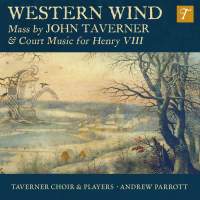Texte paru dans: / Appeared in: |
|
|
Outil de traduction ~ (Très approximatif) |
|
|
Reviewer: J.
F. Weber The first recording of Taverner’s “Western Wind” Mass in a decade (and only the second in over two decades) is the centerpiece of a well-conceived program by Andrew Parrott, whose record programming in the 1980s set the standard for everyone who came after him. While the idea of filling out polyphonic Masses with chant Propers preceded him, he was an early proponent of liturgical reconstruction, filling out a polyphonic Mass with all the less familiar liturgical material. That is not the case here, however, for the only added chants are the Kyrie, not set in a Tudor Mass since it was usually troped (though not here), and the preface, properly included because the Sanctus is its textual conclusion. But he acknowledges that the four polyphonic movements should not “follow too hard on each other’s heels,” hence the brief instrumental selections that are inserted. The recordings of the “Western Wind” Mass began with choirs of men and boys from King’s College, New College, and St. John’s College, followed by two vocal ensembles and a small choral ensemble. The fifth entry was the Tallis Scholars (Fanfare 17:2), the smallest vocal ensemble on the list, which coupled it with the two later settings on the same cantus firmus by Tye and Sheppard. A detailed account of all the relevant recordings was included in that review. The most recent version had the Ars Nova Ensemble of Copenhagen led by Paul Hillier (30:5), where the matter was brought up to date. The 15 voices on the present disc match the 16 voices on both Harry Christophers’s disc (16:3) and Hillier’s, but Parrott produces the fullest sound. All seven versions are unaccompanied. The works of William Cornysh (the younger, d. 1523), Hugh Aston (c. 1485–1558), and Henry VIII form a courtly counterpoint to the sacred music of the Tudor period. Taverner is also represented by two anthems, Audivi vocem de caelo and Dum transisset Sabbatum (I), the latter just recorded in the adjoining Haec dies program but here sung in an alternate four-voice version for male voices; and a harpsichord transcription of the in nomine section of the Sanctus from his Missa Gloria tibi Trinitas, which gave its name to tunes transcribed by innumerable later composers. “Western wind” is presented three times: a recorder version of The western wynde (the cantus firmus of the Mass); Emily van Evera’s solo version of the original song, Westron wynde; and a two-voice instrumental version of both tunes. Parrott thinks that the cantus firmus originated as a counter melody to the song, so this performance is his conjectural combination of the two. He adds three vocal duets by Emily van Evera and Charles Daniels, who are adjuncts to the ensemble. One is Cornysh’s You and I and Amyas, another an anonymous Wher be ye my love?, and an anonymous O blessed Lord, how may this be. Clearly,
Parrott is continuing his imaginative program-making here after a long
absence. The couplings on his disc are unusual compared with the trio of
“Western wind” Masses on Gimell and the additional Taverner works on the
other five. It is good to hear his novel conceptions again in a different
way of hearing this Mass. | |
|
Support us financially by purchasing this disc from eiher one of these
suppliers. |
|
|
|
|
|
Cliquez l'un ou l'autre
bouton pour découvrir bien d'autres critiques de CD |
|




